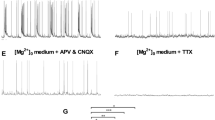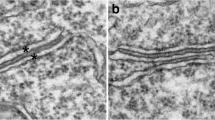Summary
Hippocampal neurones isolated from rat embryos were maintained on glial monolayers in a medium containing no L-glutamate (Glu). The administration of Glu for a limited period induced a massive death (loss) of neurones. The degree of neuronal loss increased with time after exposure to Glu. The extent of neuronal loss assessed 24 h after exposure to Glu was dependent upon the concentration Glu and on the duration of the exposure. An increase in concentration of external Ca2+ during the exposure to Glu enhanced the extent of loss. By contrast, an increment in concentration of environmental Mg2+ reduced the loss. The inhibitor of spike firing, tetrodotoxin (TTX) and the suppressor of Ca2+ entry, nitrendipine, both decreased the extent of loss, when delivered prior to Glu. The toxicity of Glu became progressively more apparent with further days of culture. The cytosolic concentration of Ca2+ ([Ca2+]i) in single hippocampal neurones was monitored by microscopic fluorometry under conditions equivalent to those in the death assay. The time required for the recovery of [Ca2+]i from the level elevated by exposure to Glu to pre-stimulus levels closely paralleled the degree of neuronal loss; i.e. high doses of Glu, long periods of exposure, high concentrations of external Ca2+, low concentrations of external Mg2+, and extended days of culture all retarded [Ca2+]i recovery, while TTX and nitrendipine accelerated it. These findings show that neuronal death resulting from an extraneous excitation (excitotoxicity) can be analyzed in vitro. Furthermore, substantial support has been provided to the hypothesis that excitotoxicity has as an underlying mechanism, an excess loading of Ca2+ in neuronal cytoplasm.
Similar content being viewed by others
Abbreviations
- APV:
-
2-amino-5-phosphonovalerate
- Asp:
-
L-aspartate
- BSS:
-
basal salt solution
- [Ca2+]i :
-
cytosolic Ca2+ concentration
- Glu:
-
L-glutamate
- NMDA:
-
N-methyl-D-aspartate
- TTX:
-
tetrodotoxin
References
Abe K, Kogure K, Yamamoto H, Imazawa M, Miyamoto K (1987) The mechanism of arachidonic acid liberation during ischemia in gerbil cerebral cortex. J Neurochem 48: 503–509
Banker GA, Cowan WM (1977) Rat hippocampal neurons in dispersed cell culture. Brain Res 126: 397–425
Benveniste H, Drejer J, Schousboe A, Diemer NH (1984) Elevation of the external concentrations of glutamate and aspartate in rat hippocampus during transient cerebral ischemia monitored by intracerebral microdialysis. J Neurochem 43: 1369–1374
Choi DW (1985) Glutamate neurotoxicity in cortical cell culture is calcium dependent. Neurosci Lett 58: 293–297
Choi DW (1987) Ionic dependence of glutamate neurotoxicity in cortical cell culture. J Neurosci 7: 369–379
Collingridge GL, Kehl SJ, McLennan H (1983) Excitatory amino acids in synaptic transmission in the Schaffer collateral commissural pathway of the rat hippocampus. J Physiol (Lond) 334: 33–46
Dichter RA (1978) Rat cortical neurons in cell culture: culture methods, cell morphology, electrophysiology, and synapse formation. Brain Res 149: 279–293
Foster AC, Fagg GE (1984) Acidic amino acid binding sites in mammalian neuronal membranes: their characteristics and relationship to synaptic receptors. Brain Res Rev 7: 103–164
Grynkiewicz G, Poenie M, Tsien RY (1985) A new generation of Ca2+ indicators with greatly improved fluorescence properties. J Biol Chem 260: 3440–3450
Hayashi T (1987) Ischemic neuronal damage in hippocampus. Ph D thesis. Tohoku University School of Medicine
Hille B (1968) Charges and potentials at the nerve surface: divalent ions and pH. J Gen Physiol 51: 221–236
Johansen FF, Jørgensen MB, Diemer NH (1986) Ischemic CA-1 pyramidal cell loss is prevented by preischemic destruction of dentate gyrus granule cells. Brain Res 377: 344–347
Katzman R (1981) Blood-brain-CSF barriers. In: Siegel GJ, Albers RW, Agranoff BW, Katzman R (eds) Basic neurochemistry, 3rd edn. Little Brown, Boston, pp 497–510
Kirino T (1982) Delayed neuronal death in the gerbil hippocampus following ischemia. Brain Res 239: 57–69
Kudo Y, Ogura A (1986) Glutamate-induced increase in intracellular Ca2+ concentration in isolated hippocampal neurones. Br J Pharmacol 89: 191–198
Kudo Y, Ozaki K, Miyakawa A, Amano T, Ogura A (1986) Monitoring of intracellular Ca2+ elevation in a single neural cell using a fluorescence microscope/video camera system. Jpn J Pharmacol 41: 345–351
Lemasters JJ, DiGiuseppi J, Nieminen AL, Herman B (1987) Blebbing, free Ca2+ and mitochondrial membrane potential preceding death in hepatocytes. Nature 325: 78–80
McLennan H (1987) Setting the scene: the excitatory amino acids — 30 years on. In: Hicks TP, Lodge D, McLennan H (eds) Excitatory amino acid transmission. Alan Liss, New York, pp 1–18
Meyer ML, Westbrook GL, Guthrie PB (1984) Voltage-dependent block by Mg2+ of NMDA responses in spinal cord neurones. Nature 309: 261–263
Nakamura Y, Kobayashi J, Gilmore J, Mascal M, Rinehart KL Jr, Nakamura H, Ohizumi Y (1986) Bromo-eudistomidin D, a novel inducer of calcium release from fragmented sarcoplasmic reticulum that causes contractions of skinned muscle fibers. J Biol Chem 261: 4139–4142
Neher E, Almers W (1986) Fast calcium transients in rat peritoneal mast cells are not sufficient to trigger exocytosis. EMBO J 5: 51–53
Norberg K, Siesjö BK (1975) Cerebral metabolism in hypoxic hypoxia. I. Pattern of activation of glycolysis: a reevaluation. Brain Res 86: 31–44
Nowak L, Bregestovski P, Ascher P, Herbet A, Prochiantz A (1984) Magnesium gates glutamate-activated channels in mouse central neurones. Nature 307: 462–465
Ogura A, Kudo Y, Amano T (1986) Glutamate-evoked intracellular Ca2+ elevation in single hippocampal neurons: its development under culture. Jpn J Physiol 48: 205
Ogura A, Miyamoto M, Amano T, Kudo Y (1987a) Glutamateinduced cell death and cytosolic calcium in cultured hippocampal neurons. Jpn J Physiol 49: 366
Ogura A, Iijima T, Amano T, Kudo Y (1987b) Optical monitoring of excitatory synaptic activity between cultured hippocampal neurons by a multi-site Ca2+ fluorometry. Neurosci Lett 78: 69–74
Onodera H, Iijima K, Kogure K (1986a) Mononucleotide metabolism in the rat brain after transient ischemia. J Neurochem 46: 1704–1710
Onodera H, Sato G, Kogure K (1986b) Lesions to Schaffer collaterals prevent ischemic death of CA1 pyramidal cells. Neurosci Lett 68: 169–174
Pulsinelli WA (1985) Selective neuronal vulnerability: morphological and molecular characteristics. Prog Brain Res 63: 29–37
Pulsinelli WA, Brierley JB, Plum F (1982) Temporal profile of neuronal damage in a model of transient forebrain ischemia. Ann Neurol 11: 499–509
Rothman SM (1985) The neurotoxicity of excitatory amino acids is produced by passive chloride influx. J Neurosci 5: 1483–1489
Rothman SM, Thurston JH, Hauhart RE (1987) Delayed neurotoxicity of excitatory amino acids in vitro. Neuroscience 22: 471–480
Sakamoto N, Kogure K, Kato H, Ohtomo H (1986) Disturbed Ca2+ homeostasis in the gerbil hippocampus following brief transient ischemia. Brain Res 364: 372–376
Schanne FAX, Kane AB, Young EE, Farber JL (1979) Calcium dependence of toxic cell death: a final common pathway. Science 206: 700–702
Simon RP, Swan JH, Griffiths T, Meldrum BS (1984) Blockade of N-methyl-D-aspartate receptors may protect against ischemic damage in the brain. Science 226: 850–852
Suzuki R, Yamaguchi T, Li CL, Klatzo I (1983) The effects of 5-minute ischemia in Mongolian gerbils. II. Changes of spontaneous neuronal activity in cerebral cortex and CA1 sector of hippocampus. Acta Neuropathol (Berl) 60: 217–222
Tsien RY, Rink TJ, Poenie M (1985) Measurement of cytosolic free Ca2+ in individual small cells using fluorescence microscopy with dual excitation wavelength. Cell Calcium 6: 145–157
Yanagihara T, Yoshimine T, Morimoto K, Yamamoto K, Homburger HA (1985) Immunohistochemical investigation of cerebral ischemia in gerbils. J Neuropathol Exp Neurol 44: 204–215
Author information
Authors and Affiliations
Rights and permissions
About this article
Cite this article
Ogura, A., Miyamoto, M. & Kudo, Y. Neuronal death in vitro: parallelism between survivability of hippocampal neurones and sustained elevation of cytosolic Ca2+ after exposure to glutamate receptor agonist. Exp Brain Res 73, 447–458 (1988). https://doi.org/10.1007/BF00406601
Received:
Accepted:
Issue Date:
DOI: https://doi.org/10.1007/BF00406601




